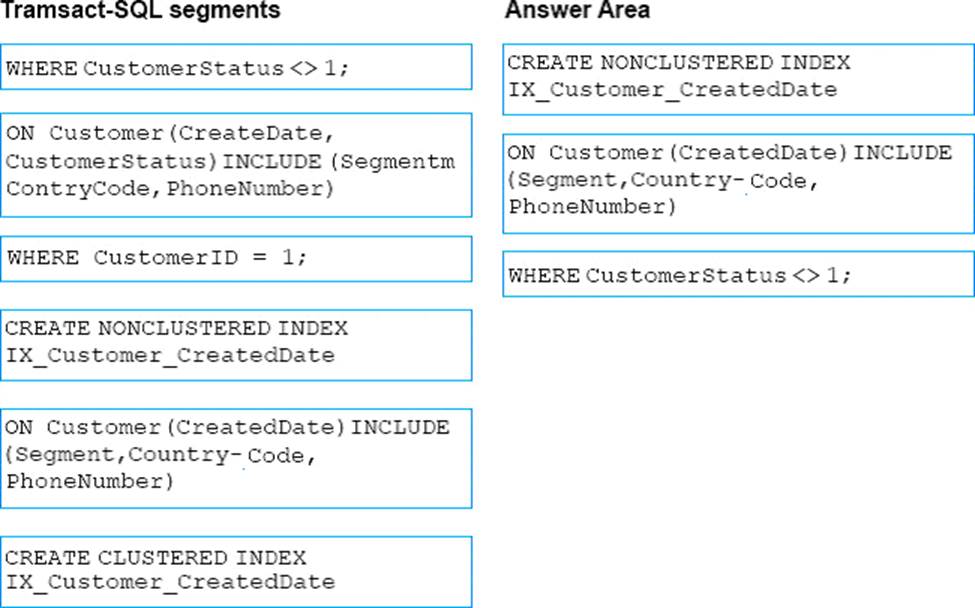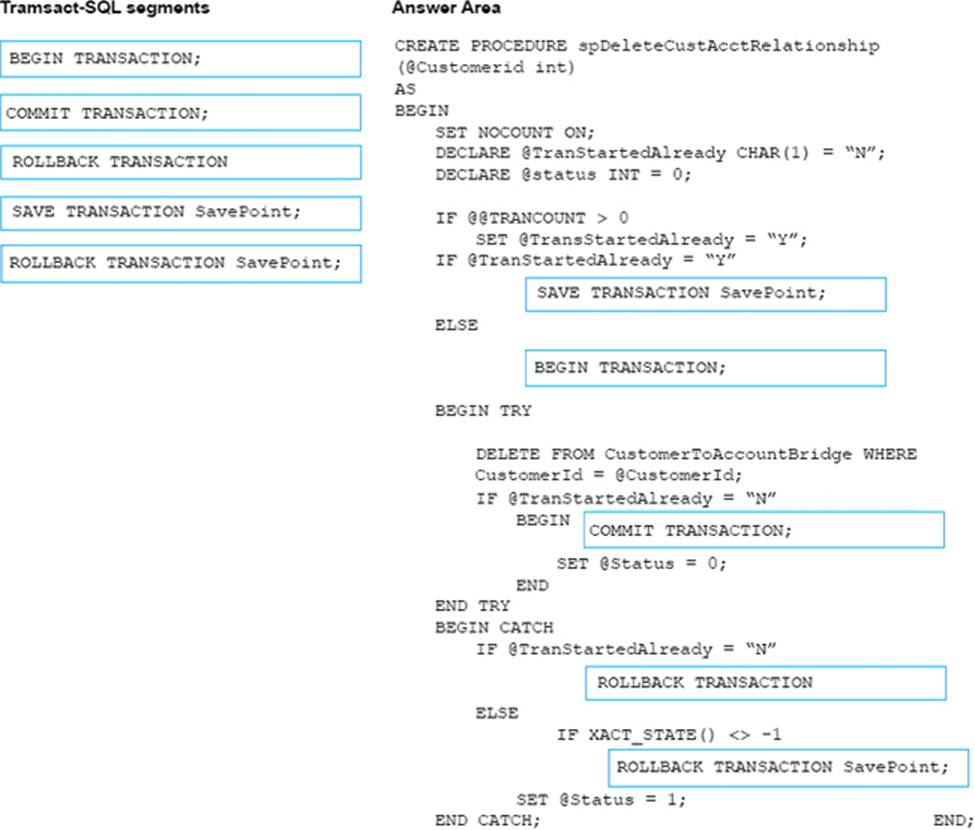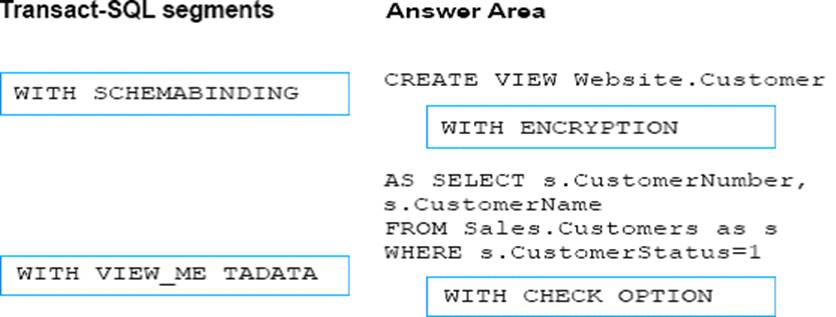Microsoft 70-762 Developing SQL Databases Online Training
Microsoft 70-762 Online Training
The questions for 70-762 were last updated at Feb 15,2025.
- Exam Code: 70-762
- Exam Name: Developing SQL Databases
- Certification Provider: Microsoft
- Latest update: Feb 15,2025
Contains all of the columns required by the SELECT statement.
Which three Transact_SQL segments should you use to develop the solution? To answer, move the appropriate code blocks from the list of code blocks to the answer area and arrange them in the correct order.
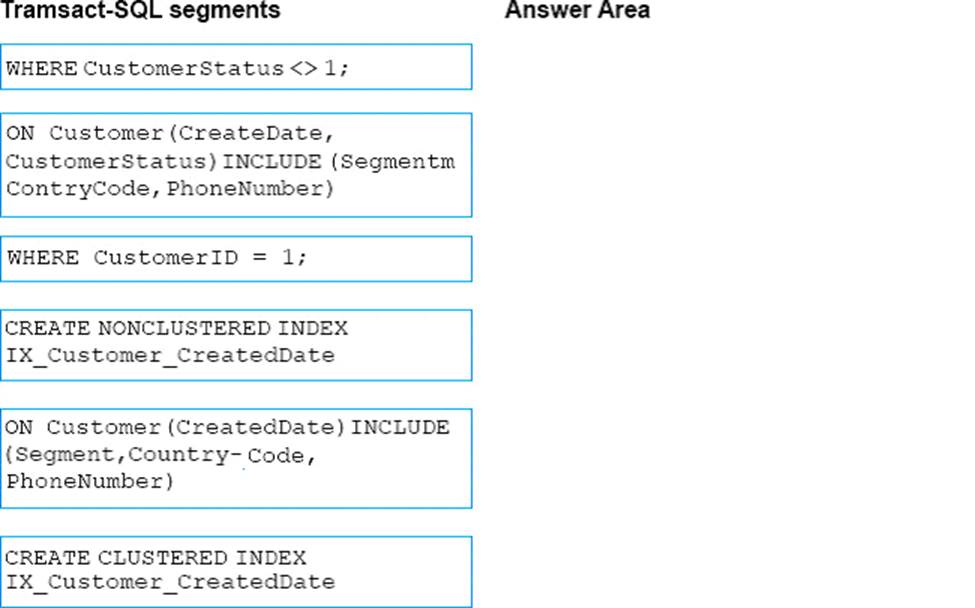
Contains all of the columns required by the SELECT statement.
Which three Transact_SQL segments should you use to develop the solution? To answer, move the appropriate code blocks from the list of code blocks to the answer area and arrange them in the correct order.

Only allow updates through the views that adhere to the view filter.
You have the following stored procedures: spDeleteCustAcctRelationship and spUpdateCustomerSummary.
The spUpdateCustomerSummary stored procedure was created by running the following Transacr-SQL statement:
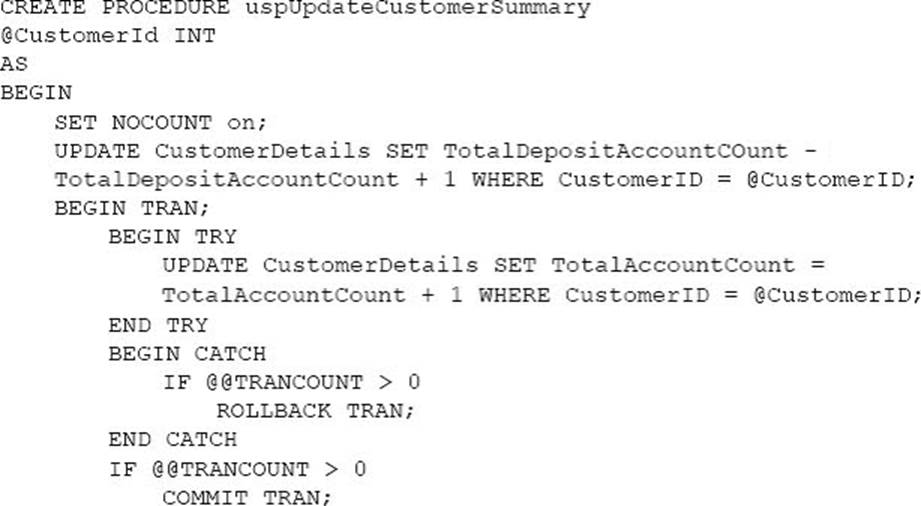
You run the spUpdateCustomerSummary stored procedure to make changes to customer account summaries. Other stored procedures call the spDeleteCustAcctRelationship to delete records from the CustomerToAccountBridge table.
When a procedure calls spDeleteCustAcctRelationship, if the calling stored procedures has already started an active transaction, all the detections made by the spDeleteCustAccRelationship stored procedure must be committed by the caller; otherwise changes must be committed within the spDeleteCustAcctRelationship stored procedure. If any error occurs during the delete operation, only the deletes made by the soDeleteCustACCTRelationships stored procedure must be rolled back and the status must be updated.
You need to complete the stored procedure to ensure all the requirements are met.
How should you complete the procedure? To answer, drag the Transact-SQL segments to the correct location. Each transact-SQL segment may be used once, more than once or not at all. You may need to drag the split bar between panes or scroll to view content. NOTE: Each correct selection is worth one point.
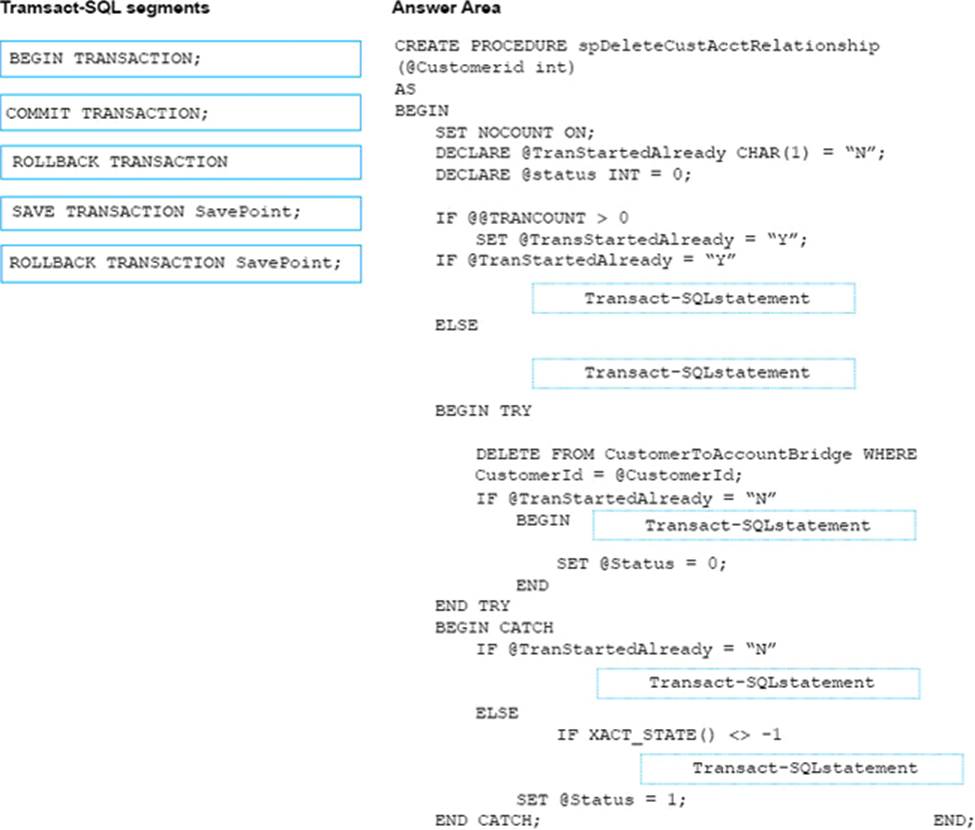
Only allow updates through the views that adhere to the view filter.
You have the following stored procedures: spDeleteCustAcctRelationship and spUpdateCustomerSummary.
The spUpdateCustomerSummary stored procedure was created by running the following Transacr-SQL statement:

You run the spUpdateCustomerSummary stored procedure to make changes to customer account summaries. Other stored procedures call the spDeleteCustAcctRelationship to delete records from the CustomerToAccountBridge table.
When a procedure calls spDeleteCustAcctRelationship, if the calling stored procedures has already started an active transaction, all the detections made by the spDeleteCustAccRelationship stored procedure must be committed by the caller; otherwise changes must be committed within the spDeleteCustAcctRelationship stored procedure. If any error occurs during the delete operation, only the deletes made by the soDeleteCustACCTRelationships stored procedure must be rolled back and the status must be updated.
You need to complete the stored procedure to ensure all the requirements are met.
How should you complete the procedure? To answer, drag the Transact-SQL segments to the correct location. Each transact-SQL segment may be used once, more than once or not at all. You may need to drag the split bar between panes or scroll to view content. NOTE: Each correct selection is worth one point.

Only allow updates through the views that adhere to the view filter.
You have the following stored procedures: spDeleteCustAcctRelationship and spUpdateCustomerSummary.
The spUpdateCustomerSummary stored procedure was created by running the following Transacr-SQL statement:

You run the spUpdateCustomerSummary stored procedure to make changes to customer account summaries. Other stored procedures call the spDeleteCustAcctRelationship to delete records from the CustomerToAccountBridge table.
When a procedure calls spDeleteCustAcctRelationship, if the calling stored procedures has already started an active transaction, all the detections made by the spDeleteCustAccRelationship stored procedure must be committed by the caller; otherwise changes must be committed within the spDeleteCustAcctRelationship stored procedure. If any error occurs during the delete operation, only the deletes made by the soDeleteCustACCTRelationships stored procedure must be rolled back and the status must be updated.
You need to complete the stored procedure to ensure all the requirements are met.
How should you complete the procedure? To answer, drag the Transact-SQL segments to the correct location. Each transact-SQL segment may be used once, more than once or not at all. You may need to drag the split bar between panes or scroll to view content. NOTE: Each correct selection is worth one point.

Only allow updates through the views that adhere to the view filter.
You have the following stored procedures: spDeleteCustAcctRelationship and spUpdateCustomerSummary.
The spUpdateCustomerSummary stored procedure was created by running the following Transacr-SQL statement:

You run the spUpdateCustomerSummary stored procedure to make changes to customer account summaries. Other stored procedures call the spDeleteCustAcctRelationship to delete records from the CustomerToAccountBridge table.
When a procedure calls spDeleteCustAcctRelationship, if the calling stored procedures has already started an active transaction, all the detections made by the spDeleteCustAccRelationship stored procedure must be committed by the caller; otherwise changes must be committed within the spDeleteCustAcctRelationship stored procedure. If any error occurs during the delete operation, only the deletes made by the soDeleteCustACCTRelationships stored procedure must be rolled back and the status must be updated.
You need to complete the stored procedure to ensure all the requirements are met.
How should you complete the procedure? To answer, drag the Transact-SQL segments to the correct location. Each transact-SQL segment may be used once, more than once or not at all. You may need to drag the split bar between panes or scroll to view content. NOTE: Each correct selection is worth one point.

Only allow updates through the views that adhere to the view filter.
You have the following stored procedures: spDeleteCustAcctRelationship and spUpdateCustomerSummary.
The spUpdateCustomerSummary stored procedure was created by running the following Transacr-SQL statement:

You run the spUpdateCustomerSummary stored procedure to make changes to customer account summaries. Other stored procedures call the spDeleteCustAcctRelationship to delete records from the CustomerToAccountBridge table.
When a procedure calls spDeleteCustAcctRelationship, if the calling stored procedures has already started an active transaction, all the detections made by the spDeleteCustAccRelationship stored procedure must be committed by the caller; otherwise changes must be committed within the spDeleteCustAcctRelationship stored procedure. If any error occurs during the delete operation, only the deletes made by the soDeleteCustACCTRelationships stored procedure must be rolled back and the status must be updated.
You need to complete the stored procedure to ensure all the requirements are met.
How should you complete the procedure? To answer, drag the Transact-SQL segments to the correct location. Each transact-SQL segment may be used once, more than once or not at all. You may need to drag the split bar between panes or scroll to view content. NOTE: Each correct selection is worth one point.

Only allow updates through the views that adhere to the view filter.
You have the following stored procedures: spDeleteCustAcctRelationship and spUpdateCustomerSummary.
The spUpdateCustomerSummary stored procedure was created by running the following Transacr-SQL statement:

You run the spUpdateCustomerSummary stored procedure to make changes to customer account summaries. Other stored procedures call the spDeleteCustAcctRelationship to delete records from the CustomerToAccountBridge table.
When a procedure calls spDeleteCustAcctRelationship, if the calling stored procedures has already started an active transaction, all the detections made by the spDeleteCustAccRelationship stored procedure must be committed by the caller; otherwise changes must be committed within the spDeleteCustAcctRelationship stored procedure. If any error occurs during the delete operation, only the deletes made by the soDeleteCustACCTRelationships stored procedure must be rolled back and the status must be updated.
You need to complete the stored procedure to ensure all the requirements are met.
How should you complete the procedure? To answer, drag the Transact-SQL segments to the correct location. Each transact-SQL segment may be used once, more than once or not at all. You may need to drag the split bar between panes or scroll to view content. NOTE: Each correct selection is worth one point.

Only allow updates through the views that adhere to the view filter.
You have the following stored procedures: spDeleteCustAcctRelationship and spUpdateCustomerSummary.
The spUpdateCustomerSummary stored procedure was created by running the following Transacr-SQL statement:

You run the spUpdateCustomerSummary stored procedure to make changes to customer account summaries. Other stored procedures call the spDeleteCustAcctRelationship to delete records from the CustomerToAccountBridge table.
When a procedure calls spDeleteCustAcctRelationship, if the calling stored procedures has already started an active transaction, all the detections made by the spDeleteCustAccRelationship stored procedure must be committed by the caller; otherwise changes must be committed within the spDeleteCustAcctRelationship stored procedure. If any error occurs during the delete operation, only the deletes made by the soDeleteCustACCTRelationships stored procedure must be rolled back and the status must be updated.
You need to complete the stored procedure to ensure all the requirements are met.
How should you complete the procedure? To answer, drag the Transact-SQL segments to the correct location. Each transact-SQL segment may be used once, more than once or not at all. You may need to drag the split bar between panes or scroll to view content. NOTE: Each correct selection is worth one point.

Only allow updates through the views that adhere to the view filter.
You have the following stored procedures: spDeleteCustAcctRelationship and spUpdateCustomerSummary.
The spUpdateCustomerSummary stored procedure was created by running the following Transacr-SQL statement:
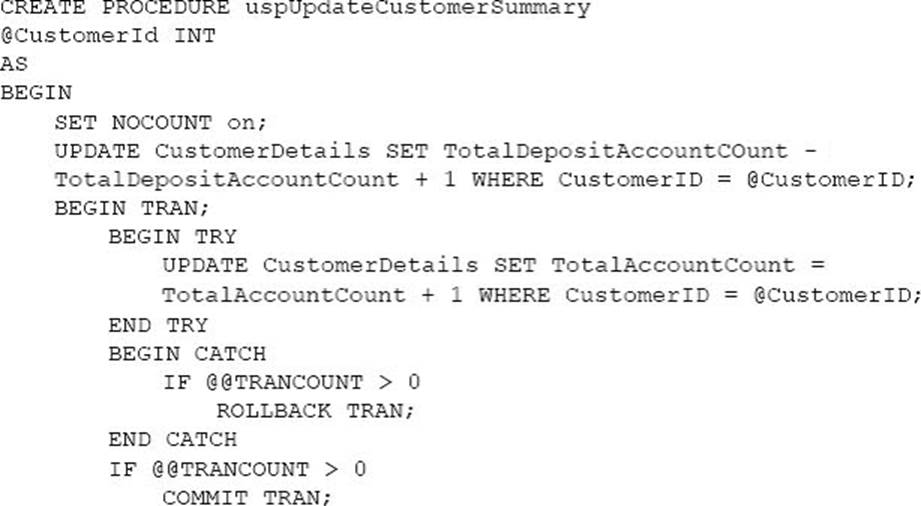
You run the spUpdateCustomerSummary stored procedure to make changes to customer account summaries. Other stored procedures call the spDeleteCustAcctRelationship to delete records from the CustomerToAccountBridge table.
You need to create Website Customer.
How should you complete the view definition? To answer, drag the appropriate Transact-SQL segments to the correct locations, Each Transact-SQL segment may be used once, more than once or not at all. You may need to drag the split bar between panes or scroll to view content.
NOTE: Each correct selection is worth one point.
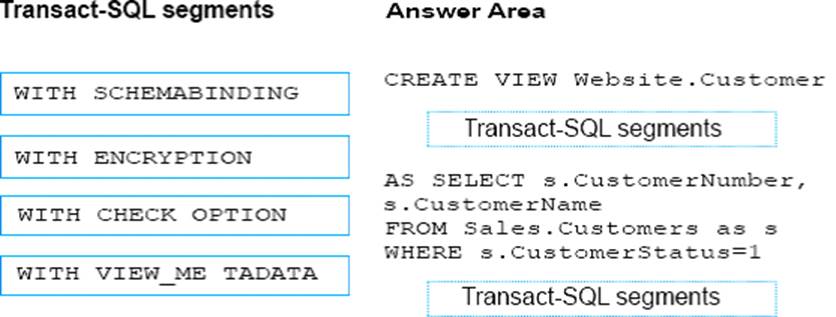
Latest 70-762 Dumps Valid Version with 157 Q&As
Latest And Valid Q&A | Instant Download | Once Fail, Full Refund

